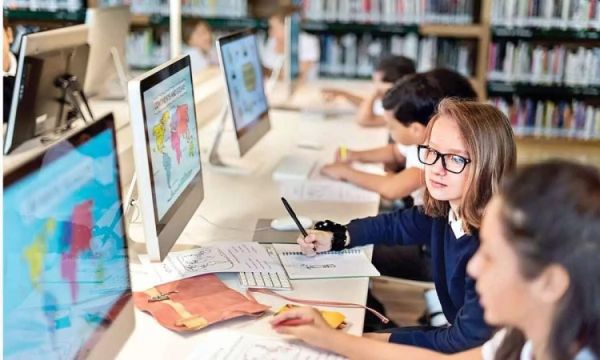
The path of Anthony Fernandes, the founder and director of Shaalaa, has been a combination of perseverance and devotion. He entered the fields of technology and human resource management after earning his MBA, which taught him important management and collaboration skills. He worked on a variety of computer initiatives throughout the years, including building websites, configuring networks, and providing web server services. He experienced difficulties as a first-generation business owner, but he remained inspired by his goal of establishing a one-stop shop for students. His goal is to provide all Indian students access to thorough educational materials so they may succeed academically.

He highlights ethical and critical thinking techniques while talking about how AI changes student research by increasing productivity, facilitating sophisticated analysis, and encouraging creativity.
A few quotes taken from an interview Education is being revolutionized by artificial intelligence (AI). In your opinion, what part does it play in enabling student researchers in the digital era?
Indeed, artificial intelligence is changing education, especially when it comes to student research. Students are able to approach, complete, and present their work in a more innovative and efficient manner because to it. AI technologies greatly improve the research process by helping with anything from literature reviews to data analysis. Though AI has a lot of promise, there are drawbacks as well, such as prejudice, inaccuracy, and ethical issues. The secret is to carefully integrate AI with conventional research techniques.
Which are the main ways that AI is now being used into student research?
In student research, artificial intelligence is used in three main ways:
1. Posing Questions and Getting Answers: AI systems enable students to pose queries and get prompt responses. Although this is excellent for brainstorming and fast searches, students should critically assess the material since AI-generated answers are sometimes prejudiced or erroneous.
2. Literature Review and Information Gathering: AI-powered databases make it easier to find books, articles, and other academic materials. These technologies let students concentrate on examining high-quality content while saving time by sifting massive volumes of information.
3. Data Analysis and Interpretation: AI’s capacity to swiftly analyze vast information and provide insights is revolutionary, particularly in STEM domains. With no technical knowledge, it enables students to do tasks like sentiment analysis and predictive modeling.
What are the benefits of using AI technologies in research?
AI has a number of advantages:
• Efficiency and Automation: By automating repetitive processes like data organization, graph generation, and draft proofreading, more time can be allocated to in-depth research.
• Access to Advanced Tools: Students may now use advanced analytical tools that were previously only available to expert researchers thanks to artificial intelligence.
• Increased Customization: AI systems often include elements that can be customized, allowing students to modify their processes to suit certain requirements and increase the productivity and personalization of their study.
What obstacles must students overcome in order to use AI in their research?
Despite its strength, AI has several drawbacks.
• Bias and Inaccuracy: AI may provide skewed or incorrect results by reinforcing biases from its training data.
In fields like the social sciences and humanities, this is particularly difficult.
• Technology Dependency: Relying too much on AI might impede the growth of analytical and problem-solving abilities. Instead of actively participating in the research process, students run the danger of becoming passive consumers.
• Privacy and Ethical Issues: Using AI brings up issues with data privacy and the morality of depending on insights produced by machines.
To preserve academic integrity, students must carefully handle these challenges.
How may these difficulties be lessened?
Accountability and transparency are essential. Researchers ought to:
• Clearly describe the usage of AI technologies.
• Recognize the biases and limits of the AI systems in use.
• Verify results produced by AI against reliable, non-AI sources.
Through cultivating an environment of openness, students may respect moral principles while utilizing AI’s potential.
How can students reconcile utilizing AI with learning the fundamentals of research?
Making ensuring AI enhances conventional research abilities rather than replacing them is crucial. The following are some recommended practices:
• Developing Core Research Skills: Students should keep honing their academic writing, critical analysis, and hypothesis-forming abilities.
• Using a Hybrid Approach: Students may take use of technology while still having a practical grasp of the research process by combining AI tools with traditional techniques.
• Ongoing Education: To assist students in ethically navigating the complexity of AI, educational institutions need to provide instruction on its ethical use.
What role do you think AI will have in education in the future?
By automating repetitive work, facilitating sophisticated analysis, and increasing access to resources, artificial intelligence (AI) has the potential to completely transform education.
AI has the potential to improve education and equip pupils to succeed in a digital environment if it is used carefully. But we have to give ethical issues, critical thinking, and adherence to conventional methods top priority. The future generation of researchers and innovators will be empowered by this equilibrium.
Regarding AI in research, what guidance would you provide educators and students?
I would advise students to embrace artificial intelligence (AI) as a tool to improve their research, but not to depend only on it. Develop your critical thinking and curiosity. I urge educators to help students use AI in an ethical and responsible manner, making sure it complements fundamental research techniques. We can work together to realize AI’s promise and build a future where technology enhances human creativity rather than replaces it.